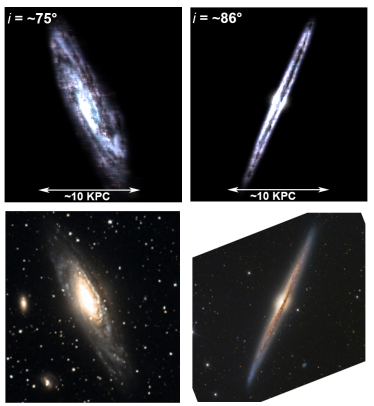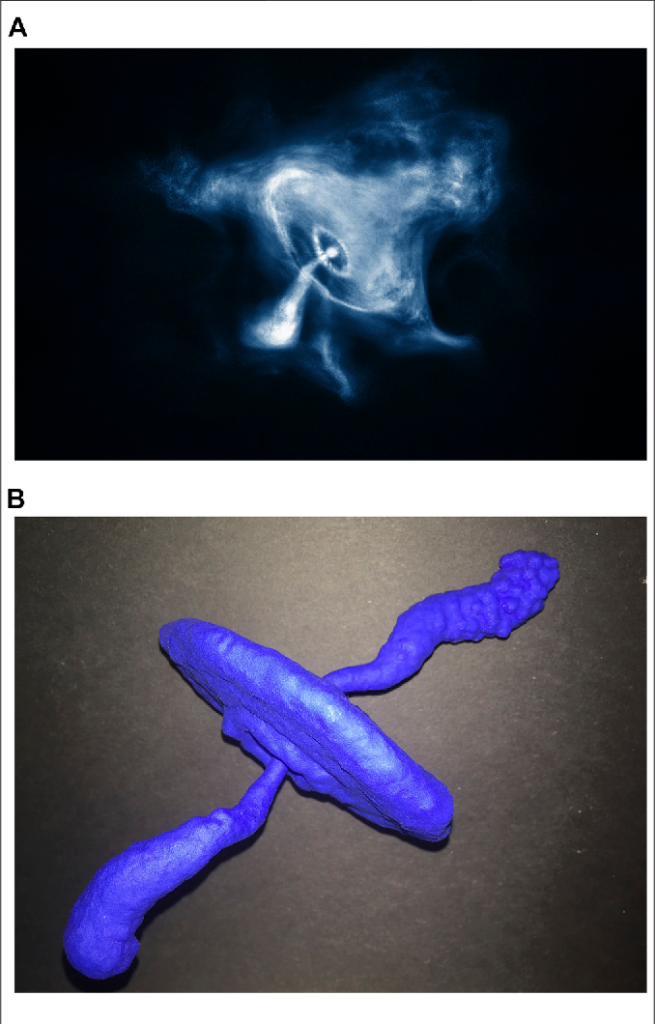
To all ShapeX users:
A bug that causes incompletely rendered images and PV-diagrams at significant inclination angles of the camera has now been fixed. Please, refer to the DOWNLOADS area of the ShapeX website for an update patch and instructions.


To all ShapeX users:
A bug that causes incompletely rendered images and PV-diagrams at significant inclination angles of the camera has now been fixed. Please, refer to the DOWNLOADS area of the ShapeX website for an update patch and instructions.
High school student Ryan Clairmont from San Diego´s Canyon Crest Academy (USA), wins “First Award” in the Physics & Astronomy category at the International Science and Engineering Fair (ISEF) with his project “Evolution of the Cat’s Eye Nebula revealed through morpho-kinematic and hydrodynamical modelling”.
To recreate this intriguing nebula, which also bears the scientific name “NGC 6543”, Ryan employed the ShapeX software developed by astrophysicists at the Institute of Astronomy (UNAM, Mexico) and the University of Calgary (Canada).
With his volumetric morpho-kinematic and hydrodynamic modelling he reached new scientific conclusions about the events that led to the complex structure of the nebula. Ryan used his own backyard telescope and spectrograph to obtain overall density information for the nebula. For the detailed modelling Ryan used images from the Hubble Space Telescope as a reference. To further constrain the spatial information along the line of sight, kinematic spectroscopy data were necessary. These were obtained from the “Kinematic Catalogue of Planetary Nebulae” (KinCatPN) published by the San Pedro Mártir National Astronomical Observatory in Baja California (Mexico) .
For details on the science check out Ryan´s virtual project board at ISEF (registration required).
W.S.

Tim Dykes, Claudio Gheller, Bärbel S. Koribalski, Klaus Dolag, Mel Krokos
Observational astronomers survey the sky in great detail to gain a better understanding of many types of astronomical phenomena. In particular, the formation and evolution of galaxies, including our own, is a wide field of research. Three dimensional (spatial 3D) scientific visualisation is typically limited to simulated galaxies, due to the inherently two dimensional spatial resolution of Earth-based observations. However, with appropriate means of reconstruction, such visualisation can also be used to bring out the inherent 3D structure that exists in 2D observations of known galaxies, providing new views of these galaxies and visually illustrating the spatial relationships within galaxy groups that are not obvious in 2D. We present a novel approach to reconstruct and visualise 3D representations of nearby galaxies based on observational data using the scientific visualisation software Splotch. We apply our approach to a case study of the nearby barred spiral galaxy known as M83, presenting a new perspective of the M83 local group and highlighting the similarities between our reconstructed views of M83 and other known galaxies of similar inclinations.
Journal: Astronomy and Computing, in press
Preprint: https://arxiv.org/abs/2102.02141
Submitted by: Tim Dykes
ShapeX is a 3D interactive morpho-kinematic modeling software package for astrophysics. Since 2006 it has been used in over 150 research papers as well as a number of BSc-, MSc- and PhD-Thesis. It has been used to create the model for the first ever 3D-printed nebula, the Homunculus in Eta-Carinae and other outreach and press release visualizations.
Since the last release, ShapeX has been revamped considerably. In particular, the user interface (UI) and the rendering algorithms have seen changes.
For more information on ShapeX and to download the software go to the website and user manual.
Nico Koning & Wolfgang Steffen
3-D stereo vision for television and cinema are dead, again. In astronomy, however, we must extend its realm. There are good reasons to do so. The first is that there are very few spatial cues to perceive depth in astronomical images (compared to the potentially nine cues in pictures of our daily environment). Opacity, haze and symmetry are the only ones that work to some extent. So, seeing the space in space is not something that humans have been primed for.
At ilumbra we pursue the hope that 3-D viewing using stereo vision and interactive manipulation improves the visual interpretation of nebulae. To achieve that we need 3-D models. For reasons of realism, we want them to be volumetric and as astrophysical as possible. For interactive 3-D models in live presentations, those attributes are rather new on main-stream graphics cards. With ilumbra´s new iluvia software all that is now possible with a few clicks of a button…right in your web browser…for public talks or even interactive exhibits in science center or for-fun exploration at home. Iluvia is still under development. At ilumbra.com we are therefore interested in your comments and suggestions. Don´t hesitate to drop us a note via contact.ilumbra@gmail.com or the contact form on ilumbra.com.
W.S.
3D Astrophysics Newsletter 2020.11
Salvatore Orlando, Ignazio Pillitteri, Fabrizio Bocchino, Laura Daricello, and Laura Leonardi
In the first half of 2019, we launched 3DMAP-VR1 (three-dimensional Modeling of Astrophysical Phenomena in Virtual Reality), a project aimed at visualizing 3D MHD models of astrophysical simulations, using VR sets of equipment. The models account for all the relevant physical processes in astrophysical phenomena: gravity, magnetic-field-oriented thermal conduction, energy losses due to radiation, gas viscosity, deviations from proton–electron temperature equilibration, deviations from the ionization equilibrium, cosmic rays acceleration, etc. (e.g., Orlando et al. 2011, 2015, 2016, 2017).
[This is part of the complete research note by Orlando et al.; for the full note see the link below.]
Journal: Research Notes of the AAS, Volume 3, Number 11
Interactive visualizations: https://sketchfab.com/sorlando/collections/universe-in-hands
The 3D Astrophysics Newsletter is a free service by ilumbra.com.
3D Astrophysics Newsletter 2020.10
Kimberly K. Arcand, Sara R. Price, Megan Watzke

Abstract
Three-dimensional (3D) visualization has opened up a universe of possible scientific data representations. 3D printing has the potential to make seemingly abstract and esoteric data sets accessible, particularly through the lens of translating data into forms that can be explored in the tactile modality for people who are blind or visually impaired. This article will briefly review 3D modeling in astrophysics, astronomy, and planetary science, before discussing 3D printed astrophysical and planetary geophysical data sets and their current and potential applications with non-expert audiences. The article will also explore the prospective pipeline and benefits of other 3D data outputs in accessible scientific research and communications, including extended reality and data sonification.
Keywords: 3D printing, 3D visualization, virtual reality, astrophysics, geophysics,
science communication, inclusivity
Journal: Frontiers in Earth Science, 2020, DOI: 10.3389/feart.2020.590295
Arxiv: https://arxiv.org/ftp/arxiv/papers/2012/2012.02789.pdf
Submitted by: Sara Price
The 3D Astrophysics Newsletter is a free service by ilumbra.com.
2020.9
A New Galactic Center Adventure in Virtual Reality
Christopher Russell, Baltasar Luco, Jorge Cuadra, and Miguel Sepúlveda
More information: @ NASA Press release with video.
Reference: Russell, C. et al. 2017, MNRAS, 464, 4958, arXiv:1607.01562
The 3D Astrophysics Newsletter is a free service by ilumbra.com.
2020.8
Detailed studies of IPHAS sources — I. The disrupted late bipolar IPHASX J193718.6+202102
Sabin, L.;Guerrero, M. A.;Zavala, S.;Toalá, J. A.;Ramos-Larios, G.;Gómez-Llanos, V.
Abstract: We present a detailed analysis of the new planetary nebula (PN) IPHASX J193718.6+202102 using deep imaging and intermediate- and high resolution spectroscopy that are interpreted through morpho-kinematic and photoionisation modelling. The physical structure of the nebula consists of a fragmented torus and an extremely faint orthogonal bipolar outflow, contrary to the pinched waist PN morphology suggested by its optical image. Our kinematic analysis indicates that the torus is expanding at 25±5 km s−1 and is gradually breaking up. At an estimated distance of 7.1−0.3+0.8 kpc, the corresponding kinematic age of ∼26000 years is consistent with a faint and disintegrating PN. The intermediate-resolution spectra reveal an excited PN with chemical abundances typical of Type II PNe. Based on the latter we also estimate an initial mass for the progenitor in the range 2-3 M⊙ and a central star (CSPN) mass MCSPN∼0.61 M⊙. The Spitzer MIPS 24 μμm emission that closely follows the fragmented torus could be attributed to the emission of [O IV] at 25.9 μμm rather than to dust emission. All the results coherently point towards an evolved moderately massive bipolar Type II PN on the brink of dissolving into the interstellar medium.
Journal: Monthly Notices of the Royal Astronomical Society (MNRAS), in press
Preprint
2020.7
A triple-star system with a misaligned and warped circumstellar disk shaped by disk tearing
Stefan Kraus, Alexander Kreplin, Alison K. Young, Matthew R. Bate, John D. Monnier, Tim J. Harries, Henning Avenhaus, Jacques Kluska, Anna S. E. Laws, Evan A. Rich, Matthew Willson, Alicia N. Aarnio, Fred C. Adams, Sean M. Andrews, Narsireddy Anugu, Jaehan Bae, Theo ten Brummelaar, Nuria Calvet, Michel Curé, Claire L. Davies, Jacob Ennis, Catherine Espaillat, Tyler Gardner, Lee Hartmann, Sasha Hinkley, Aaron Labdon, Cyprien Lanthermann, Jean-Baptiste LeBouquin, Gail H. Schaefer, Benjamin R. Setterholm, David Wilner, Zhaohuan Zhu
Abstract: Young stars are surrounded by a circumstellar disk of gas and dust, within which planet formation can occur. Gravitational forces in multiple star systems can disrupt the disk. Theoretical models predict that if the disk is misaligned with the orbital plane of the stars, the disk should warp and break into precessing rings, a phenomenon known as disk tearing. We present observations of the triple-star system GW Orionis, finding evidence for disk tearing. Our images show an eccentric ring that is misaligned with the orbital planes and the outer disk. The ring casts shadows on a strongly warped intermediate region of the disk. If planets can form within the warped disk, disk tearing could provide a mechanism for forming wide-separation planets on oblique orbits.
Journal: Science, Vol. 369, Issue 6508, pp. 1233-1238
Preprint: https://arxiv.org/abs/2004.01204
Submitted by: Stefan Kraus